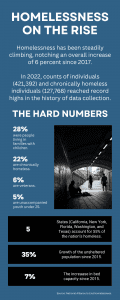As nine Supreme Court justices mull the fate of the nation’s roughly 650,000 homeless, new research from Portland State University’s Homelessness Research & Action Collaborative (HRAC) indicates that alternative shelters provide better outcomes than traditional shelters.
The study, conducted for Multnomah County’s Joint Office of Homeless Services (JOHS), broke down the cost, experiences, and outcomes in village-style and motel shelters vs. traditional shelters.
“This research shows that motel and village shelters, which provide private living spaces that support the autonomy, dignity, and safety of clients, lead to better experiences and more positive outcomes than congregate shelters,” HRAC assistant director Jacen Greene said.
Courts Consider Housing Crisis
The case, City of Grants Pass, Oregon v. Gloria Johnson, is the first significant homeless case to land in DC in more than 40 years. Grants Pass city council members passed ordinances in 2013 that outlawed overnight camping in public spaces, which included city streets and sidewalks.
Gloria Johnson – and a bevy of other homeless people – sued the city. The group pushed back, claiming the new laws violated the Eighth Amendment’s prohibition of cruel and unusual punishment.
The 9th U.S. Circuit Court of Appeals agreed and froze enforcement of the statutes.
The Supreme Court heard oral arguments this week, under the shadow of a housing shortage that numbers anywhere between 4 million and 7 million units.
“We know that communities are better and stronger for everyone when all its residents have a safe and affordable place to call home,” the National Alliance to End Homelessness CEO Ann Oliva said in a statement. “We also know that our nation’s current affordable housing crisis, and the resulting increases in unsheltered homelessness, has been building for decades. Elected leaders must act to fund and implement evidence-based approaches to these crises that impact some of our nation’s most vulnerable and marginalized residents, including people of color, people with disabilities, LGBTQ people, and, increasingly, older adults.”
New Approach to Homeless Housing
Village and motel shelter models have emerged as popular options lately as a way to supplement a dearth of traditional shelters.
In Portland, for example, local agencies have supervised the construction of multiple villages to support a growing homeless population. This new research suggests this new village model is more attractive for its intended recipients and more cost-effective for the community.
The study also reveals that the success rate for moving someone into this alternative housing model is higher
“Alternative shelters provide participants with levels of privacy, autonomy, and safety that are not always present in congregate shelters,” the report reads. “These factors helped participants feel like they could pause, breathe, and work toward their goals.”
Compared to other shelter models, according to the study, villages have the lowest capital costs per unit when the land is free. Still, they are more expensive than motel or congregate shelters if land costs and pod replacements are considered. Motel shelters are often faster to set up and are more flexible in terms of conversion to housing, but can be difficult to set up due to supply.
When it comes to cost, HRAC also found that moving someone into housing and providing support services — such as rental assistance — is at least comparable to the cost of paying for a shelter bed. It also costs less than alternative shelters.
“We found that placing somebody into housing, paying their rent, and providing supportive services is usually a less costly alternative than any type of temporary shelter, and is the only approach that ends homelessness,” Greene added.
Better-Informed Homeless Policies
These results offer some guidance for policymakers struggling to figure out which works best for which situation. The study’s authors argue that an effective shelter strategy should include:
- Utilize shelter types with individual, private rooms.
- Size shelters to a smaller total number of units.
- Center equity in services and programming.
- Include identity-supportive shelters and/or programming.
- Locate shelters close to essential services and amenities.
- Consider long-term shelter costs and site usage/conversion potential in planning.
- Incorporate input and feedback from people with lived experience of homelessness.
“Ultimately, any shelter strategy should be viewed as a temporary stopgap until enough housing can be provided to address current and forecasted needs,” the authors wrote. “Someone in a shelter is still experiencing homelessness, and the only true solution to homelessness is to ensure that people who are housed are able to remain there, and people who are unhoused are placed in housing as soon as possible.”
Further Reading
Psychiatric Disorders in Hospitalized Homeless Individuals



